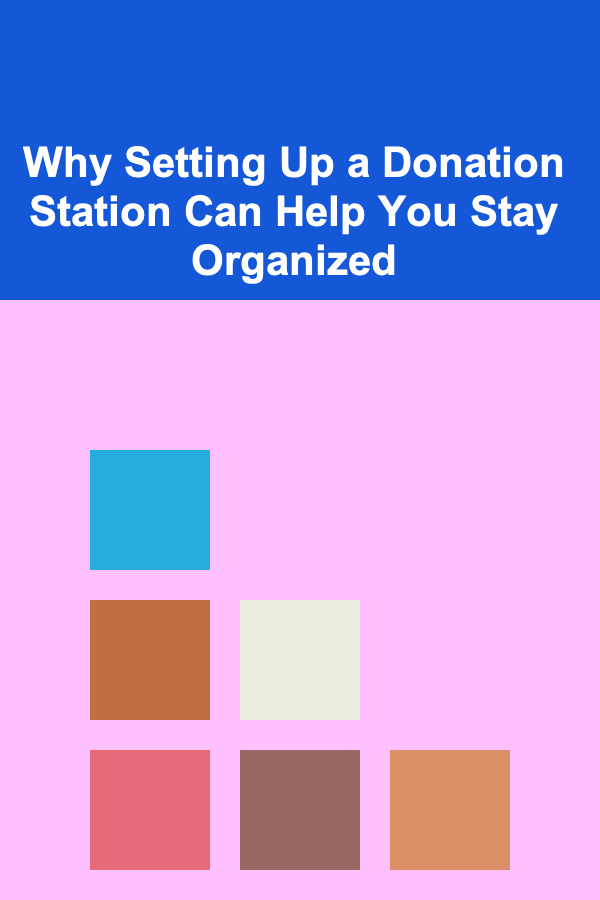
10 Tips for Organizing Your Quilting Fabric Stash
ebook include PDF & Audio bundle (Micro Guide)
$12.99$8.99
Limited Time Offer! Order within the next:
Not available at this time

Quilting is an art that brings together creativity, tradition, and craft. One of the key components of quilting is fabric---beautiful, colorful fabric that can transform a simple piece of cloth into a piece of art. However, when you accumulate fabrics for various projects, keeping your quilting fabric stash organized can be a challenge. A cluttered fabric stash can lead to frustration and wasted time spent searching for the right materials. Fortunately, with a few strategic tips, you can organize your quilting fabric stash in a way that makes it easy to access and enjoy.
Here are 10 tips for organizing your quilting fabric stash that will help keep your sewing space neat and your quilting process more efficient.
Sort by Color
One of the easiest ways to organize your quilting fabric stash is by color. Color is often the first thing you look for when searching for fabric for a project, so having your fabrics sorted by color can make them much easier to access. You can use color bins, drawers, or fabric organizers to store your fabrics in color-coded sections.
Action Steps:
- Group similar colors together: Arrange your fabrics into categories such as reds, blues, yellows, greens, and neutrals. You can also add separate sections for prints, solids, and multi-color fabrics.
- Use fabric storage bins: Invest in clear bins or drawers to store your fabrics, making sure the color categories are clearly labeled for easy access.
By organizing your fabrics by color, you'll always know where to look when you need a specific hue for your project.
Sort by Fabric Type or Theme
Another way to organize your fabric stash is by the type of fabric or theme. Different types of fabrics have different textures, weights, and uses, so organizing by fabric type can make it easier to choose the right fabric for a particular project. For example, you may want to group cotton, linen, wool, and silk fabrics separately.
Additionally, if you tend to buy fabrics based on themes for specific projects (such as holiday fabrics, florals, or vintage prints), organizing them by theme can also save you time.
Action Steps:
- Group fabric types: Sort your fabric by its material---cotton, silk, linen, etc.---and store each group in separate bins or boxes.
- Create theme-based sections: Consider setting aside space for seasonal fabrics, novelty prints, or any fabrics you specifically buy for certain projects.
Sorting by fabric type or theme is ideal if you tend to work with different textures or plan your projects around specific motifs.
Use a Fabric Folding Method
Properly folding your fabrics is crucial for both organization and fabric longevity. Fabrics that are folded neatly take up less space, are easier to stack, and are less likely to wrinkle. The way you fold your fabric can affect how easily you can see what you have, so finding a method that works for you is important.
Action Steps:
- Use a ruler to fold fabric: A common method is to fold your fabric around a 6-inch ruler or cardboard template. This ensures each piece of fabric is folded to a consistent size.
- Use fabric bolts: If you have a larger fabric stash, consider using fabric bolts or wrap your fabrics on foam core boards for a neat, uniform look.
- Store fabrics vertically: Store folded fabrics vertically (like books on a shelf) rather than stacking them horizontally to maximize visibility and minimize fabric distortion.
Folding fabrics this way keeps them neat, accessible, and ensures they remain in good condition.
Create a Fabric Inventory List
If you have a large fabric stash, it might be difficult to keep track of everything you own. Keeping an inventory list of your fabrics can help you know exactly what you have on hand and avoid overbuying duplicates. This will also make it easier to plan future quilting projects because you'll already know which fabrics are available to you.
Action Steps:
- Keep a digital or physical inventory: Create a spreadsheet or use a fabric inventory app to list your fabrics, their colors, types, and quantities. If you prefer physical records, write down fabric details in a notebook.
- Take photos of fabrics: For digital records, take photos of each fabric and add them to the inventory. This is especially useful for fabrics that are difficult to describe.
- Update your inventory regularly: Every time you buy new fabric or use up a piece, update your list to keep it current.
By maintaining an inventory list, you'll know exactly what you have and can plan your next quilting project accordingly.
Use Clear Storage Containers
Clear plastic bins or containers allow you to see the contents without opening them, making it easy to find what you need quickly. This also helps keep your fabric stash protected from dust, dirt, and sunlight, which could damage your fabric over time. Additionally, clear containers help maintain a visually organized space that looks tidy and appealing.
Action Steps:
- Choose bins with lids: Select containers that are sturdy and come with tight-fitting lids to keep dust and debris out.
- Label bins clearly: Label your storage containers by color, fabric type, or theme to make it easier to find what you're looking for.
Clear storage bins are a great way to keep your fabric stash organized while protecting your investment.
Store Scraps Separately
Scraps are an inevitable part of quilting, and they can quickly pile up. Instead of letting scraps take over your workspace, create a separate section for them. By organizing your scraps, you can keep them accessible for future projects without cluttering your main fabric stash.
Action Steps:
- Sort scraps by size: Keep a bin for larger scraps that are still useful for quilting, and a separate one for small scraps that can be used for patchwork or appliqué.
- Label your scraps: Just like your fabric stash, label your scrap bins so you can quickly grab the right size piece when needed.
- Repurpose scraps: Consider using your scraps in scrap quilts, mini projects, or even donating them to others who might need small pieces for their crafts.
Organizing scraps is key to minimizing waste and maximizing the utility of your fabric stash.
Organize Your Fabric by Project
If you often start projects but don't always finish them right away, organizing your fabric stash by project is a great way to keep your work organized. You can dedicate separate bins or folders for each project, making it easy to grab the fabrics you need when you're ready to continue.
Action Steps:
- Create project bins: Store all the fabrics you plan to use for a specific quilt or project in one container. This will keep everything you need for that project in one place.
- Include notions and patterns: In addition to fabric, keep your sewing patterns, notions, and other supplies with the project's fabric to keep everything organized.
By organizing by project, you can stay on track and ensure that all your materials for a specific quilt are together and easily accessible.
Use a Fabric Rolling System
If you don't have a lot of shelving or bins to store your fabric, you can also consider rolling your fabric. Rolling fabric not only helps save space but also keeps it wrinkle-free. You can also quickly see the fabric you have available when rolling it into color or type categories.
Action Steps:
- Roll fabric tightly: Start from one end of the fabric and roll it into a compact cylinder. Make sure it's rolled evenly so that the fabric won't get misshaped.
- Store rolls in clear containers: Use clear baskets or bins to store your fabric rolls neatly. Keep them organized by color, theme, or type for easy access.
Rolling fabric is a great space-saving method, and it makes finding the perfect piece of fabric a lot easier.
Maintain a Fabric Stash Management Routine
Maintaining an organized fabric stash requires ongoing effort. It's easy for fabric to accumulate and get disorganized over time, especially if you buy new fabrics frequently. Set aside time each month or season to clean up your stash, update your inventory, and reassess your storage needs.
Action Steps:
- Schedule regular cleanups: Every few months, go through your fabric stash and assess if anything needs to be reorganized or if you've accumulated too much.
- Rearrange as needed: Over time, you may find that your storage system no longer works for you. Don't be afraid to tweak or adjust your organizational methods to make them more effective.
Keeping up with fabric organization will ensure your quilting space stays neat and that your fabric stash remains easy to manage.
Make Use of Vertical Space
If your quilting space is small, using vertical space can help you maximize your storage options. Shelves, pegboards, and wall-mounted organizers can help store your fabrics without taking up valuable floor space. Vertical storage can also make it easier to view and access your fabrics.
Action Steps:
- Install shelves: Use sturdy shelving units to store your fabrics in bins or stacks. Make sure the shelves are adjustable so you can adapt the space to your needs.
- Use wall-mounted organizers: Hang organizers like pegboards or fabric baskets on the wall to store smaller pieces of fabric or your sewing tools.
By utilizing vertical space, you can create a more functional and efficient quilting workspace.
Conclusion
An organized fabric stash is essential for any quilter who wants to work efficiently and avoid the frustration of searching for the perfect fabric. By using these 10 tips, you can create a quilting fabric storage system that works for you and helps keep your sewing space neat and tidy. Whether you prefer sorting by color, type, theme, or project, there are many ways to keep your fabric stash organized and accessible. With a little effort and creativity, you'll be ready to tackle your next quilting project with ease.

How to Create a Family-Friendly DIY Home Escape Room
Read More
How to Offer Tailoring Services Part-Time and Make Money from Home
Read More
How to Set Up a Command Center for Family Management
Read More
How to Soundproof a Home Library with Acoustic Solutions
Read More
Why Setting Up a Donation Station Can Help You Stay Organized
Read More
10 Tips for Avoiding Common Real Estate Investing Mistakes
Read MoreOther Products

How to Create a Family-Friendly DIY Home Escape Room
Read More
How to Offer Tailoring Services Part-Time and Make Money from Home
Read More
How to Set Up a Command Center for Family Management
Read More
How to Soundproof a Home Library with Acoustic Solutions
Read More
Why Setting Up a Donation Station Can Help You Stay Organized
Read More